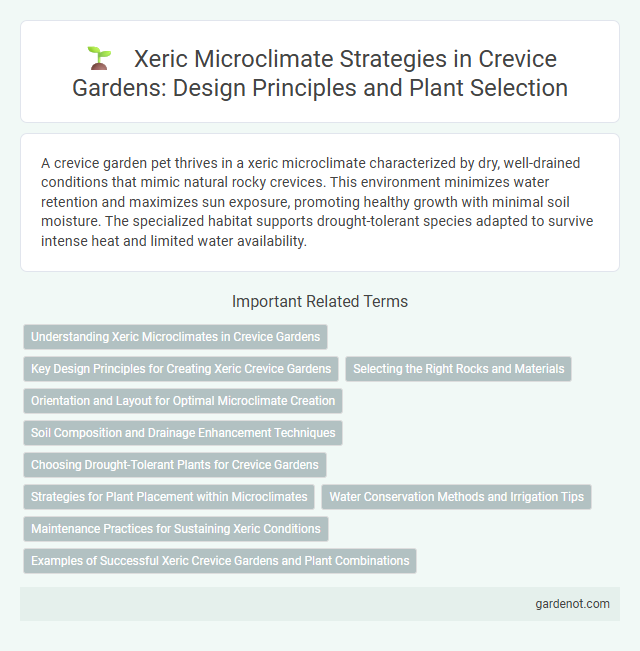A crevice garden pet thrives in a xeric microclimate characterized by dry, well-drained conditions that mimic natural rocky crevices. This environment minimizes water retention and maximizes sun exposure, promoting healthy growth with minimal soil moisture. The specialized habitat supports drought-tolerant species adapted to survive intense heat and limited water availability.
Understanding Xeric Microclimates in Crevice Gardens
Xeric microclimates in crevice gardens create ideal conditions for drought-tolerant plants by mimicking arid environments with excellent drainage and intense sunlight exposure. These microhabitats maintain low moisture levels through narrow stone fissures that minimize water retention, supporting specialized succulent and alpine species adapted to limited water availability. Understanding the temperature fluctuations and soil composition within xeric zones is crucial for cultivating resilient plants that thrive in crevice garden settings.
Key Design Principles for Creating Xeric Crevice Gardens
Xeric crevice gardens require precise stone placement to mimic natural rock formations, promoting efficient water drainage and minimal soil retention. Selecting drought-tolerant, deep-rooting plants adapted to arid environments ensures resilience in the microclimate. Maximizing sun exposure and incorporating narrow crevices maintain moisture balance and temperature regulation essential for xeric ecosystems.
Selecting the Right Rocks and Materials
Selecting the right rocks and materials for a crevice garden is essential to creating a xeric microclimate that mimics natural arid conditions. Opt for porous stones such as sandstone or limestone, which facilitate excellent drainage and prevent water retention around plant roots. Incorporate coarse gravel and sand to enhance soil aeration and reduce moisture, ensuring a dry environment ideal for drought-tolerant plants.
Orientation and Layout for Optimal Microclimate Creation
Crevice gardens optimize xeric microclimates through strategic orientation, ensuring maximum sun exposure on south-facing walls to retain heat. The layout incorporates narrow, deep fissures that enhance air circulation while minimizing moisture loss, creating ideal drought-resistant conditions. Placement of stones and plants further modulates temperature fluctuations, promoting a stable microenvironment for xerophytic species.
Soil Composition and Drainage Enhancement Techniques
Crevice gardens leverage a xeric microclimate by utilizing coarse, well-draining soil compositions rich in sand, gravel, and organic matter to mimic natural arid environments. Incorporating layers of crushed stone and grit enhances drainage, preventing water retention that could harm drought-tolerant plants adapted to dry conditions. Strategic soil layering and rock placement promote air circulation and rapid moisture evaporation, crucial for maintaining the specialized ecosystem within crevice gardens.
Choosing Drought-Tolerant Plants for Crevice Gardens
Selecting drought-tolerant plants such as sedums, sempervivums, and drought-resistant succulents enhances the xeric microclimate of crevice gardens by maximizing water efficiency. These species thrive in minimal soil and withstand intense sunlight and limited moisture, making them ideal for narrow soil pockets. Incorporating native drought-tolerant perennials also supports biodiversity while ensuring robust plant survival in harsh, dry crevice environments.
Strategies for Plant Placement within Microclimates
Xeric microclimates in crevice gardens require strategic plant placement to maximize water efficiency and sun exposure. Drought-tolerant species are positioned in areas with the highest heat and minimal shade, while moisture-loving plants thrive in cooler crevices that retain more humidity. Utilizing soil depth variations and rock orientation enhances microhabitats, ensuring optimal root growth and temperature regulation for diverse xerophytic plants.
Water Conservation Methods and Irrigation Tips
Crevice gardens create a xeric microclimate by maximizing air circulation and minimizing soil moisture retention, promoting drought-tolerant plant growth. Water conservation methods include using deep, narrow soil beds to reduce evaporation and mulching with gravel or sand to retain soil moisture. Irrigation tips emphasize infrequent, deep watering to encourage root depth while preventing overwatering in the confined soil spaces.
Maintenance Practices for Sustaining Xeric Conditions
Maintaining xeric conditions in a crevice garden involves regular monitoring of soil moisture levels to prevent overwatering, which can disrupt the drought-tolerant microclimate. Utilizing mulch and well-draining substrates helps retain minimal moisture and promotes aeration essential for xerophytic plants. Periodic removal of invasive species and careful pruning ensure that water usage remains low and the microhabitat stays stable for native xeric flora.
Examples of Successful Xeric Crevice Gardens and Plant Combinations
Xeric crevice gardens thrive in arid microclimates by utilizing deep, narrow rock fissures that retain moisture and provide shade, creating ideal conditions for drought-tolerant plants. Successful examples include combinations of Sempervivum, Sedum, and Artemisia, which adapt well to minimal water and intense sunlight. These plant groups benefit from the crevice garden's natural drainage and protection, promoting sustained growth and vibrant foliage in xeric environments.
Xeric microclimate Infographic

 gardenot.com
gardenot.com